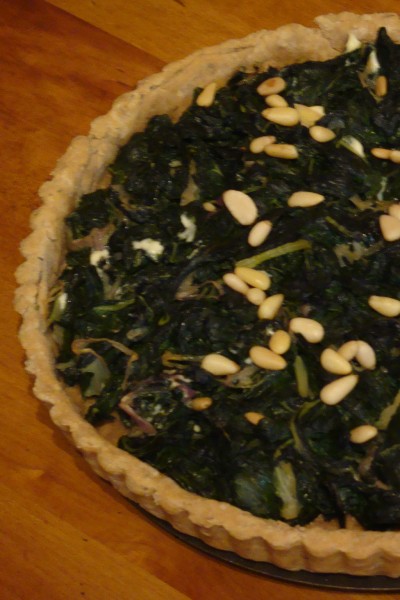 Our friend here might not win any beauty contests, but I love her just the same. She is virtuous, straightforward, and (crucially) delicious. She’s also a perfect foil to any new-found habits one might have with duck fat.
Our friend here might not win any beauty contests, but I love her just the same. She is virtuous, straightforward, and (crucially) delicious. She’s also a perfect foil to any new-found habits one might have with duck fat.
She wasn’t my idea, though. I see Swiss chard at farmers’ markets, buy bunches with abandon, and watch it all wilt slowly, gently in my refrigerator for a week or ten or twelve or even fourteen days. Subsequently guilt stricken, I sauté it in some olive oil, add pine nuts and dried currants, serve it with a poached egg on top, some bread on the side, and think meh. It’s nice, but gets a little boring as it is exactly the only thing I do with Swiss chard.
Or was. A visit with my dear friend Charles in Texas over the winter holiday changed all this. His mother has a garden that includes all kinds of chard, for which the growing season in Texas is apparently always and the haul amounts to tons. She—her name is Françoise and her cooking is fabulous—mentioned quite early in my visit that she wanted to make a tarte aux blettes, a Swiss chard tart. I love quiche, and really loved the idea of focusing more on the vegetable and less on the eggs + cream. But we never made our tarte aux blettes, and where I live, the growing season for Swiss chard is not always like it is in Austin. Which is to say that Françoise’s tarte-aux-blettes-to-be has been waiting in my stomach’s eye for a good four months now. This is trying for a stomach’s patience.
But at long last, there was chard at my farmers’ market this week. I bought bunches with abandon, and ate it, too. This thing of virtue will be a joy forever.
Swiss chard tart with goat cheese + pine nuts
Pine nuts and dried currants do go well with Swiss chard, but the dried fruits were too sweet for me in this. The shallots stood in to add a bit of depth and sweetness, and the goat’s cheese is there just because. Regardless of what you choose to put in the tart filling, it’s quite important that all components be dried thoroughly so that the crust does not become soggy.
For a 9″ or 10″ tart mold: 4 bunches Swiss chard, cleaned and with stalks removed | 2 shallots, sliced thinly | olive oil | salt + pepper | goat’s cheese, crumbled, to taste | lemon | nutmeg | 1 egg, lightly beaten | 1 partially baked tart crust (recipe follows) | small handful pine nuts
Heat oven to 350.
Wilt the chard in a big pot set over low-ish heat and covered. Stir from time to time so that the leaves on the bottom don’t cook so much more than the leaves on top. When it’s all cooked down, drain well (drink the chard water!), and chop roughly. Squeeze out any excess moisture.
While the chard is cooling, sauté the shallots, seasoned with salt and pepper, in some olive oil over medium heat until translucent, perhaps 5 minutes. Scrape onto paper towels to drain.
Mix together the chard, shallots, goat’s cheese, a squeeze of lemon juice and grating of nutmeg in a big bowl. Taste for seasoning and adjust as necessary. When you are satisfied, stir in the egg, and scrape it all into the tart shell.
Bake until set, about 20 minutes, scattering a small handful of pine nuts over the tart for the last 5 minutes of cooking.
Olive oil tart crust
This recipe comes from that fantastic food blog Chocolate & Zucchini. The only adaptation I’ve made is to halve the salt. As a full teaspoon of kosher salt made the crust very salty, I suspect that the salt used in that recipe is somewhat different from the kosher salt we usually find stateside. Otherwise, I love this preparation and intend to use it for lots and lots of tarts to come.
250 g wheat flour | 1 tsp dried herbs like thyme or rosemary (optional) | ½ tsp kosher salt | 60 ml/¼ cup olive oil | 120 ml/½ cup water
If you will bake the crust, heat oven to 400.
Mix ingredients together with a fork in the order listed above, blending just enough for the mixture to be clumpy. Use your hands to bring the mixture together, knead a couple of times if necessary, and roll it out. If, like me, you do not have or want a rolling pin, use an old wine bottle, but do wash the thing first. Slide the crust into the tart mold (buttered and floured if necessary), clean up the edges and patch up holes or thin bits. You will not need the entire quantity for a 9″ or 10″ mold. The leftover can be cut into cute shapes and used to decorate the top of the tart or for snacks as crackers. If you have 30 minutes during which you can let it rest in the refrigerator, do so. (I did not and was not bothered.) If par-baking for the Swiss chard tart, prick the bottom of the crust many times with a fork and bake for about 7 minutes.
{ 2 comments… read them below or add one }
The Chards! The Chards!
This looks delicious and is officially being added to the “to make” folder in my google reader.
Do you know Deborah Madison? One of my favorite chard recipes comes from her giant vegetarian cookbook. (I raved all about it here: http://csafiles.blogspot.com/2009/10/have-you-lived.html)